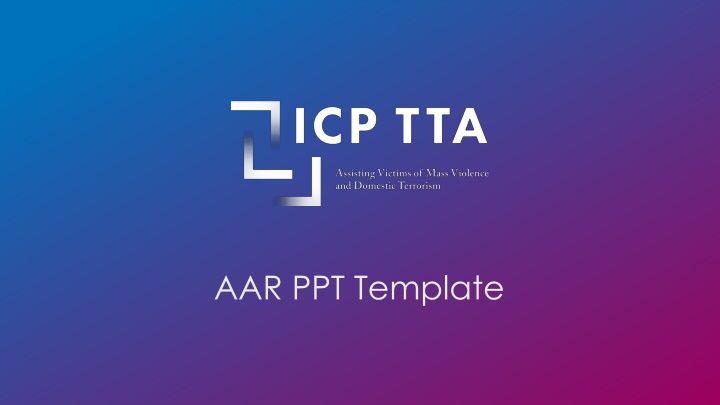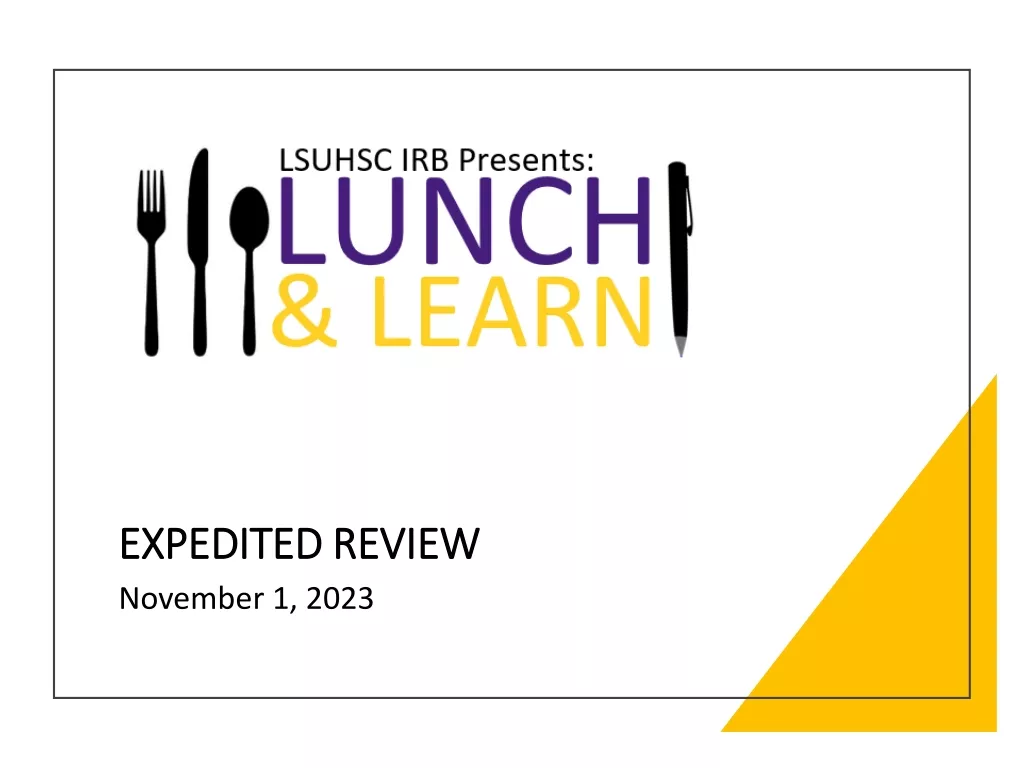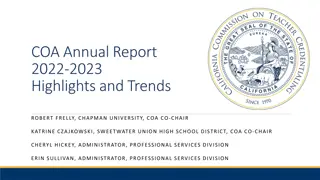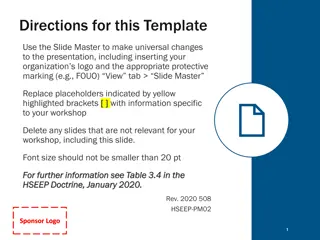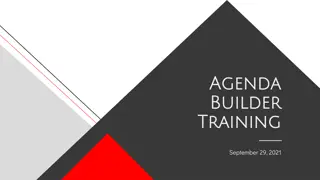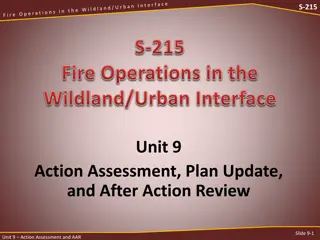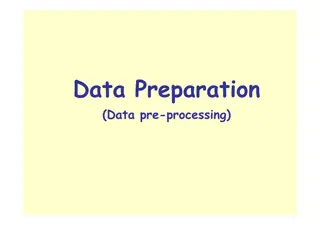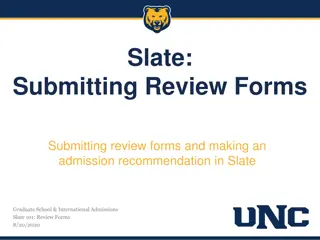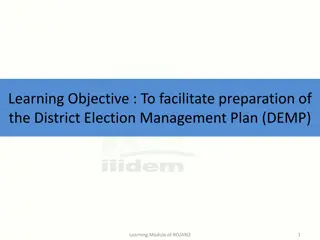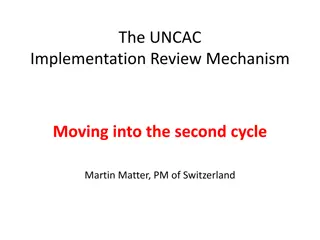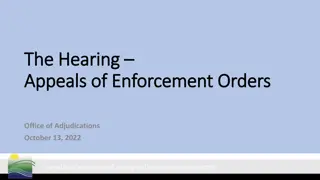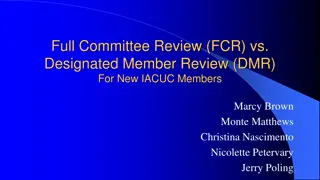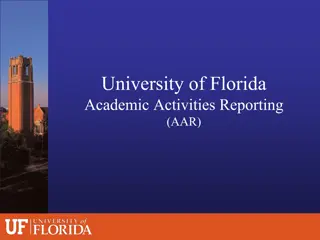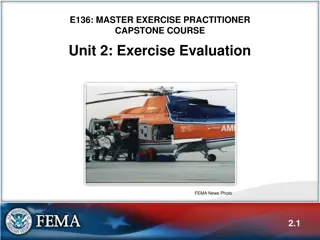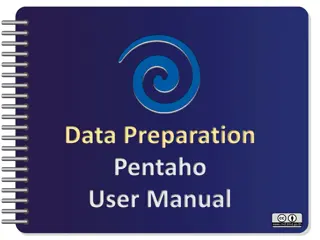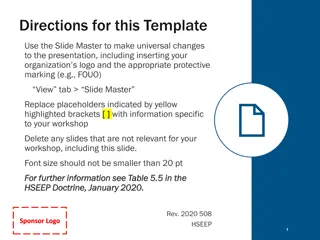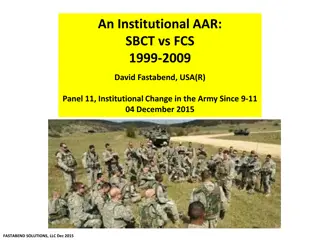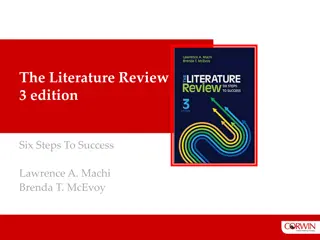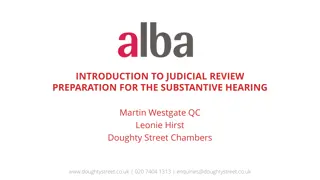AAR Preparation Steps & Review Agenda
In this template and guide, you will find detailed steps for preparing an After-Action Review (AAR) presentation. Customize the PowerPoint to suit the specifics of your exercise, incorporating survey and Exercise Evaluator feedback. Learn how to develop survey questions, select facilitators, and structure breakout groups. The agenda covers welcome and introductions, mission review, ground rules, survey results, breakout sessions, and action planning.
Uploaded on Feb 25, 2025 | 0 Views
Download Presentation

Please find below an Image/Link to download the presentation.
The content on the website is provided AS IS for your information and personal use only. It may not be sold, licensed, or shared on other websites without obtaining consent from the author.If you encounter any issues during the download, it is possible that the publisher has removed the file from their server.
You are allowed to download the files provided on this website for personal or commercial use, subject to the condition that they are used lawfully. All files are the property of their respective owners.
The content on the website is provided AS IS for your information and personal use only. It may not be sold, licensed, or shared on other websites without obtaining consent from the author.
E N D
Presentation Transcript
How to use this template Follow AAR preparation steps on slide 3. Customize the ppt to reflect the specifics of the exercise, survey feedback and Exercise Evaluator feedback. Delete slides 1-3 prior to AAR presentation.
AAR Prep Develop customized survey questions if using a survey and distribute to participants several weeks prior to AAR Identify facilitators who were not involved in the exercise to facilitate overall discussions and breakout rooms Include return date that allows for consolidating information Compile Exercise Evaluator feedback if available for inclusion in AAR Goal is to determine major focus areas to guide the AAR discussion Questions can be specific to any component of the operation [i.e. Operations, Logistics, Planning, specific site operations (FRC, FAC), specific functions (mental health, victim navigators)]. Samples given on slides 17-24. Identify Breakout Group make up to reflect diverse disciplines
XXX After Action Review FACILITATED BY: FACILITATOR FACILITATOR FACILITATOR
Welcome & Introductions Review & Rules Review of Mission, 16 Best Practices AAR Ground Rules AAR AGENDA Overview of the Exercise/Actual Event & Timeline AAR Focus Areas Review of AAR Survey Results (if conducted) Breakout Sessions & Report Outs Action Planning
Name INTRODUCTIONS What organization are you from? What was your role in this event? How long have you served in this role?
Overview Review of Mission, 16 Best Practices AAR Ground Rules Overview of the Exercise/Actual Event & Timeline
ICPTTA 16 Best Practices in Planning for CMV/DT 1. Incident Command 2. Committee Identification & Engagement 6. Public Information & Crisis Communications Protocol 3. Up-To-Date Contact List 4. Notification and Information Center 5. Victim Identification & Notification Protocol 7. Volunteer Management Protocol 8. Family and Survivor Assistance Center (FAC) Plan 9. Financial Donation Management Protocol 10. Memorial & Special Event Management Protocols 11. Community Behavioral Health Response 12. First Responder Support 13. Planning & Preparedness Grants and Emergency Funding Assistance 14. Community Resilience Planning 15. Criminal Justice System Victim Support 16. Training and Exercise 8
Rules of the AAR How can we, as members of a team and as individuals, best serve clients and the mission? Work together to keep the discussion focused. Share all relevant information This is a safe environment. It s okay to disagree, BUT RESPECT: Challenge ideas, systems, processes and solutions, NOT people or personalities. One topic at a time (Use the Parking Lot) Actively participate Keep it real. Keep it relevant. Be honest. Be direct. Be kind.
Sample Event Timeline Transition to FAC X potential victims/families identified Briefs Victims and Families/Friends Event Occurs VA and EM leadership assigned. VA support Vigils/Memorials Events Transition of FAC to Resiliency Center Aug 29 Sept 02 Sept 05-08 Sept 20/21 Aug 29 Sept 01 Sept 03 -04 Sept 12/13 FFRC established. Briefs Victims and Families/Friends Establish Financial/Donations Protocols Out-of-area staff begin to arrive FAC Director Identified Briefs Victims and Families/Friends Planned staff transitions/replacements
AAR Focus Areas Typical focus areas Team Coordination, collaboration, chain of command Mission/Service Were victim needs met? Was the response effective in meeting identified goals? Process Was the plan followed? Were processes effective? People What was the experience of the victims? What was the experience of the people involved in the response?
It can be helpful to match up Focus Areas with ICPTTA Best Practices. AAR Focus Areas: Each ICPTTA Best Practices may line up with more than one focus area. 16 Best Practices Focus Areas Possible Sub-Topics Coordination of entire response. Collaboration as opposed to EM Team vs. VS team vs. Partner Team? Psychosocial support across all areas - including own team What were the value of previous training and exercise? What do you wish you knew prior to response? Incident Command Team First Responder Support Team Training and Exercise Team Operational effectiveness. Were clients needs met? Did we follow the existing plan? If no, why did we deviate? How did we communicate with partners, EM, victims/families? Was messaging coordinated? Family Friends Reception/ Notification Center (FRC) Mission/Service Family/Friends Assistance Center (FAC) Plan Mission/Service Planning & Preparedness Grants and Emergency Funding Assistance Mission/Service
AAR Focus Areas Cont. 16 Best Practices Focus Areas Sub-Topics See sub-topics items under both Mission/Service and Process Community Resilience Planning Mission/Service & Process Inclusion of partners Client feedback and experience External partner feedback Media effects Logistics Donation management Victim Identification & Notification Protocol Process Public Information & Crisis Communications Protocol Process Financial Donation Management Protocol Process Criminal Justice System Victim Support Process See sub-topics items under both Process and people Community Behavioral Health Response Process & people Memorial & Special Event Management Protocols Process & People
AAR Focus Areas-cont 16 Best Practices Focus Areas Sub-Topics See sub-topics items under both Process and People Planning & Preparedness Grants and Emergency Funding Assistance Process & People Managing recruitment Tracking deployed human resources Volunteer Management Protocol Process & People Partner satisfaction Social media sentiment perception of response and tone set by committee Inclusion of partners External partner feedback Committee Identification & Engagement People Up-To-Date Contact List People
Assessment Results Possible survey questions and presentation of responses Exercise Evaluator feedback
Sample Survey Responses Sample Survey Responses Survey questions can be used to help facilitators develop focus areas for the AAR. Surveys are sent out to participants and returned with enough time for results to determine the direction of the AAR. The following are samples that will need to be customized to your exercise.
Survey Q1: Were victims/families-friends helped at the FFRC? If not what stopped us from helping them? Answered: 71 Skipped: 0 Sample Themes Clarity of roles and responsibilities Providing for clients needing more assistance Communications with EM/PIO/JIC
Survey Q2: Were you involved with victims at either the FRC or FAC? What worked well? Sample Themes Resources Clarity of staff assignments Training/Exercise with EM and Partners Partners working together with clear roles and responsibilities *A separate question can be added to the survey to focus on the non-victim involved tasks at the FRC or FAC.
Survey Q3: Were you involved with victims at either the FRC or FAC? What needs improvement? Sample Themes Communications with EM/PIO/Partners Volunteer coordination. Tracking victims/families-friends Larger night shift Support from partners beyond first few days *A separate question can be added to the survey to focus on the non-victim involved tasks at the FRC or FAC.
Survey Q4: How effective were we in working with partners? A. Non-government agencies and their resources? B. Government agencies and their resources? Sample Themes: Range of opinions Great support from many partners Need better communications More training/exercise with partners needed prior to event Clarity of roles and responsibilities (i.e. role of the FAC Director, Victim Services Lead/Coordinator, etc..) Gaps in the plan(s) (I.e. EM Plan or CMV/DT Annex)
Survey Q5: What suggestions do you have to improve our plan based on your experience during this event/exercise? Sample Themes Sharing CMV/DT plan more widely particularly with partners Better understanding of partner capabilities needed Broaden financial and donation management sections Transitioning from FFRC to FAC to FRC needs more details
Survey Q6: How were you kept informed of FAC priorities and activities? Sample Themes Asking Questions Daily Briefings Rumors Text Messaging/emails Staff complaints. Some individuals tried to control information flow or had another agenda
Survey Q7: What haven't we asked that you feel is important to consider for future operations? Sample Themes Following procedures Better internal and external collaboration Sharing more information before and during events Play well together Clear roles and responsibilities Particularly, leadership positions
Report on Exercise Evaluator Feedback High level feedback Organize to reflect Focus Areas Identify where Evaluators and participants may not agree
Breakout Groups Depending on the size and diversity of experience of groups involved in the AAR, Focus Areas can be addressed in a large group discussion or divided into various breakout groups. If multiple facilitators are available, using some combination of breakout groups and large group discussion is recommended. Facilitator: Jane Jones Facilitator: Jon Smith Group 1 Mission/Service and People Group 2 Process and Team Example members: EM or Incident Commander, Ops section chief, JFSO Lead, FAC Director, PIO, FFRC Director Example members: Deputy IC/Ops Section Chief, FAC Deputy, FFRC Director, Intake lead, Victim Serices lead, Communications/Community liaison, Volunteer/agency Lead, Partner Leads (i.e. Salvation Army, XYZ Faith based organization)
Breakout Groups Framing Questions Each group should discuss the following questions as it relates to their assigned subject. What was planned? What really happened? Why did it happen? What can we do better next time?
Breakout Groups Deliverables Each breakout group will create a written matrix for their assigned topic(s) and identify the following: Areas of success Areas for improvement Recommendations for how to ensure future success and/improvement. (Actions to be taken to improve performance or capacity). Select a few things within each group to focus on completing DON T TRY TO SOLVE EVERY PROBLEM. Possible timeframe for Completion Suggestions for Responsible Party Who needs to be involved
Breakout Groups Report Outs Recommendations for how to ensure future success and/improvement. Actions to be taken to improve performance or capacity Select a few things within each group to focus on completing DON T TRY TO SOLVE EVERY PROBLEM. Possible Timeframe for Completion Suggestions for Responsible Party Who needs to be involved
Improvement and Action Planning
Next Steps- Written Reporting and Planning Compile all shared information into one written document. Develop agreed upon actions and timeline Recommended Actions Timeframe for Completion Suggestions for Responsible Party Who needs to be involved Update response plan documents to reflect refined action steps
